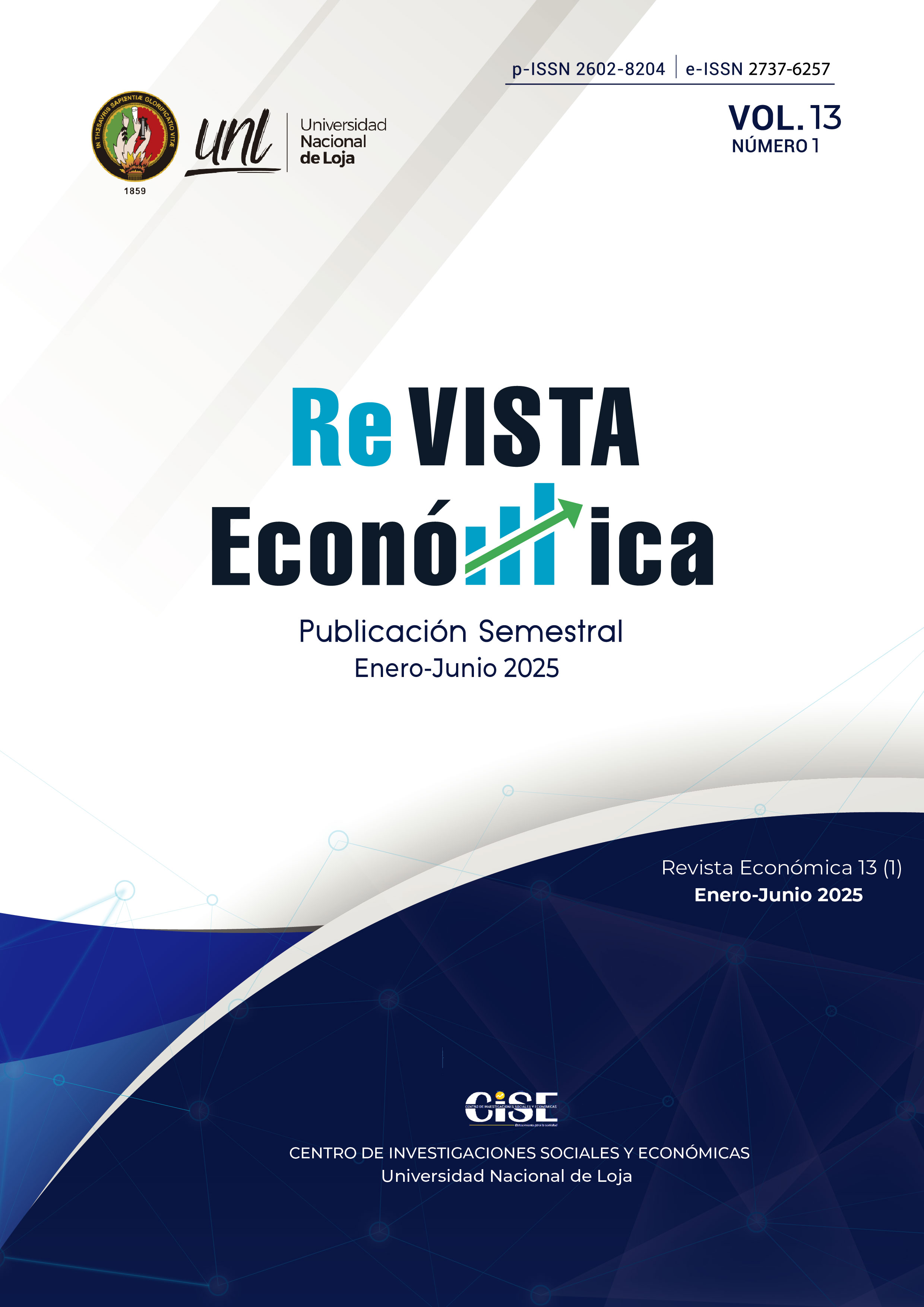Agglomeration economies in the apparel and footwear manufacturing industries in the Province of Tungurahua, Ecuador
Main Article Content
Abstract
Article Details

This work is licensed under a Creative Commons Attribution-NonCommercial-NoDerivatives 4.0 International License.
Esta obra está sujeta a la licencia Reconocimiento-NoComercial-SinObraDerivada 4.0 Internacional de Creative
Commons. Para ver una copia de esta licencia, visite http://creativecommons.org/licenses/by-nc-nd/4.0/.
References
Achabou, M. A. (2020). The effect of perceived CSR effort on consumer brand preference in the clothing and footwear sector. European Business Review, 32(2), 317–347. https://doi.org/10.1108/EBR-11-2018-0198
Aguilar Méndez, D. L., Espinoza Arauz. Mayra Yasmina, & Mera Bravo, E. P. (2022). Análisis del comportamiento de compradores de artículos de expresión social en fechas comerciales. Revista Universidad y Sociedad, 14(1), 484–492. http://scielo.sld.cu/pdf/rus/v14n1/2218-3620-rus-14-01-484.pdf
Banco Mundial. (2024). Desempleo, total (% de la fuerza laboral total) (estimación modelada de la OIT) - Ecuador. https://datos.bancomundial.org/indicator/SL.UEM.TOTL.ZS?locations=EC
Barroeta Zalaquett, M. (2021). El derecho al vestido adecuado en el Pacto Internacional de Derechos Económicos, Sociales y Culturales: Exploración de su estado y aproximación a su contenido. Anuario de Derechos Humanos, 17(2), 303. https://doi.org/10.5354/0718-2279.2021.64779
Campos, R. G., & Reggio, I. (2015). Consumption in the shadow of unemployment. European Economic Review, 78, 39–54. https://doi.org/10.1016/j.euroecorev.2015.04.006
CFN. (2022). Ficha sectorial de prendas de vestir. https://www.cfn.fin.ec/wp-content/uploads/downloads/biblioteca/2022/fichas-sectoriales-3-trimestre/Ficha-Sectorial-Prendas-de-Vestir.pdf
Chakraborty, S., & Biswas, M. C. (2020). Impact of COVID-19 on the textile, apparel and fashion manufacturing industry supply chain: Case study on a ready-made garment manufacturing industry. Journal of Supply Chain Management, Logistics and Procurement, 3(2), 181–199. https://www.ingentaconnect.com/content/hsp/jscm/2020/00000003/00000002/art00007#Refs
Escalante Semerena, R., & Lugo Olmos, I. (2005). Relación entre el crecimiento económico y las economía externas de aglomeración en México. Problemas Del Desarrollo, 36(143), 132–155. http://www.scielo.org.mx/scielo.php?script=sci_arttext&pid=S0301-70362005000200007
Fretes Ayala, P. E., Venturi, J. L., Ferreiro, H. M., Ocampo del Valle, D., & Godoy Caballero, R. C. (2021). Aglomeración empresarial como factor de desarrollo y competitividad. Revista Latinoamericana de Ciencias Sociales y Humanidades, 1(3), 97–105. https://latam.redilat.org/index.php/lt/article/download/36/31/116
Ganong, P., & Noel, P. (2016). How Does Unemployment Affect Consumer Spending? www.jpmorganchase.com/institute.
García López, M. Á., & Muñiz, I. (2010). El impacto espacial de las economías de aglomeración y su efecto sobre la estructura espacial del empleo. El caso de la industria en Barcelona, 1986-1996. Revista de Economía Aplicada, 18(52), 91–119. http://www.redalyc.org/articulo.oa?id=96912920004
Geoportal. (2024). Visor Geográfico. https://www.geoportaligm.gob.ec/portal/
Glaeser, E. L. (2010). Agglomeration economics. University of Chicago Press.
IBM Corporation. (2023). SPSS Statistics. https://www.ibm.com/planetwide/ec/
INEC. (2012). Clasificación Nacional de Actividades Económicas. https://aplicaciones2.ecuadorencifras.gob.ec/SIN/descargas/ciiu.pdf
INEC. (2023). Registro Estadístico de Empresas (REEM). https://www.ecuadorencifras.gob.ec//directoriodeempresas/
INEC. (2024). Registro Estadístico de Empresas 2023. https://www.ecuadorencifras.gob.ec/documentos/web-inec/Estadisticas_Economicas/Registro_Empresas_Establecimientos/2023/Semestre_I/Boletin_REEM_2023.pdf
Khurana, K. (2022). The Indian fashion and textile sector in and post COVID-19 times. Fashion and Textiles, 9(1), 1–16. https://doi.org/10.1186/s40691-021-00267-4
Llanos Encalada, M., & Salazar Cueva, Á. D. (2023). Efectos post pandemia en el desempeño del sector industrial textil ecuatoriano de ropa liviana: periodo 2020-2021. ECA Sinergia, 14(3), 129–141. https://doi.org/10.33936/ecasinergia.v14i3.5665
Molina Arcos, I. A., Tamayo Viera, J. O., Pérez Yauli, V. L., & Arroba Freire, E. M. (2022). Determinantes de compra del consumidor de prendas de vestir en la provincia de Tungurahua. REVISTA ERUDITUS, 3(1), 43–61. https://doi.org/10.35290/re.v3n1.2022.520
Naciones Unidas. (2024). Pacto Internacional de Derechos Económicos, Sociales y Culturales. https://www.ohchr.org/es/instruments-mechanisms/instruments/international-covenant-economic-social-and-cultural-rights
OIT. (2020). La COVID-19 y las industrias de los textiles, el vestido, el cuero y el calzado. https://www.oitcinterfor.org/sites/default/files/file_publicacion/sector_textil.pdf
Parejo, F., Rangel, J.-F., & Branco, A. (2019). Aglomeración industrial y desarrollo regional. Los sistemas productivos locales en Portugal. EURE, 45(134), 147–168. https://www.redalyc.org/articulo.oa?id=19657710007
Ravelo Méndez, R., & Mendoza Gómez, M. (2023). Competitividad Territorial y Desarrollo Local. Equidad y Desarrollo, 42, 187–206. https://doi.org/10.19052/eq.vol1.iss42.9
Rodríguez Bautista, J. J., & Cota Yáñez, R. (2022). Comportamiento de las aglomeraciones industriales en México. In La economía sectorial reconfigurando el territorio y nuevos escenarios en la dinámica urbano rural (Vol. 2, pp. 329–348). https://ru.iiec.unam.mx/5839/
Rodríguez Bautista, J. J., & Flores García, I. P. (2023). Condiciones de aglomeración de las manufacturas en México. In Nuevas territorialidades-economía sectorial y reconfiguración territorial (Vol. 2, pp. 143–162). https://ru.iiec.unam.mx/6128/
Rodríguez-Pose, D., & Sleeman, T. (2019). The Oxford Handbook of Economic Geography. In G. Clark, M. Feldman, & M. Gertler (Eds.), The Oxford Handbook of Economic Geography.
Sáez Lozano, J. L. (2001). Industrias y territorio: Análisis de las economías de aglomeración en España. Universidad de Granada.
SRI. (2024). Saiku - Next Generation Open Source Analytics. https://srienlinea.sri.gob.ec/saiku-ui/
Sumba-Bustamante, R., Saltos-Ruiz, G., Rodríguez-Suarez, C., & Tumbaco-Santiana, Z. (2020). El desempleo en el ecuador: causas y consecuencias. Ciencias Técnicas y Aplicadas, 5(10), 774–797. https://doi.org/10.23857/pc.v5i10.1851
Urdaneta Montiel, A. J., & Borgucci García, E. V. (2021). Economías de aglomeración y externalidades negativas en Ecuador, periodo 2007-2017. Cuadernos de Economía, 40(82), 165–191. https://doi.org/10.15446/cuad.econ.v40n82.81058
Vicente-Salar, R., Pallares-Barbera, M., & Vera Martín, A. (2024). Auge y declive del Distrito Textil de Trafalgar de Barcelona: un análisis espacio-temporal (1916-2016). Boletín de La Asociación de Geógrafos Españoles, 100, 1–41. https://doi.org/10.21138/BAGE.3421
Villegas, A., & Noussan Lettry, R. (2023). Comportamiento del consumidor y responsabilidad social en el caso de la tendencia en moda rápida. In XII Congreso de Administración del Centro de la República. https://www.aacademica.org/xii.congreso.de.administracion.del.centro.de.la.repoblica.viii.congreso.de.ciencias.econmicas.del/75.pdf
Yuan, X., Chen, B., He, X., Zhang, G., & Zhou, C. (2024). Spatial Differentiation and Influencing Factors of Tertiary Industry in the Pearl River Delta Urban Agglomeration. Land, 13(2). https://doi.org/10.3390/land13020172

